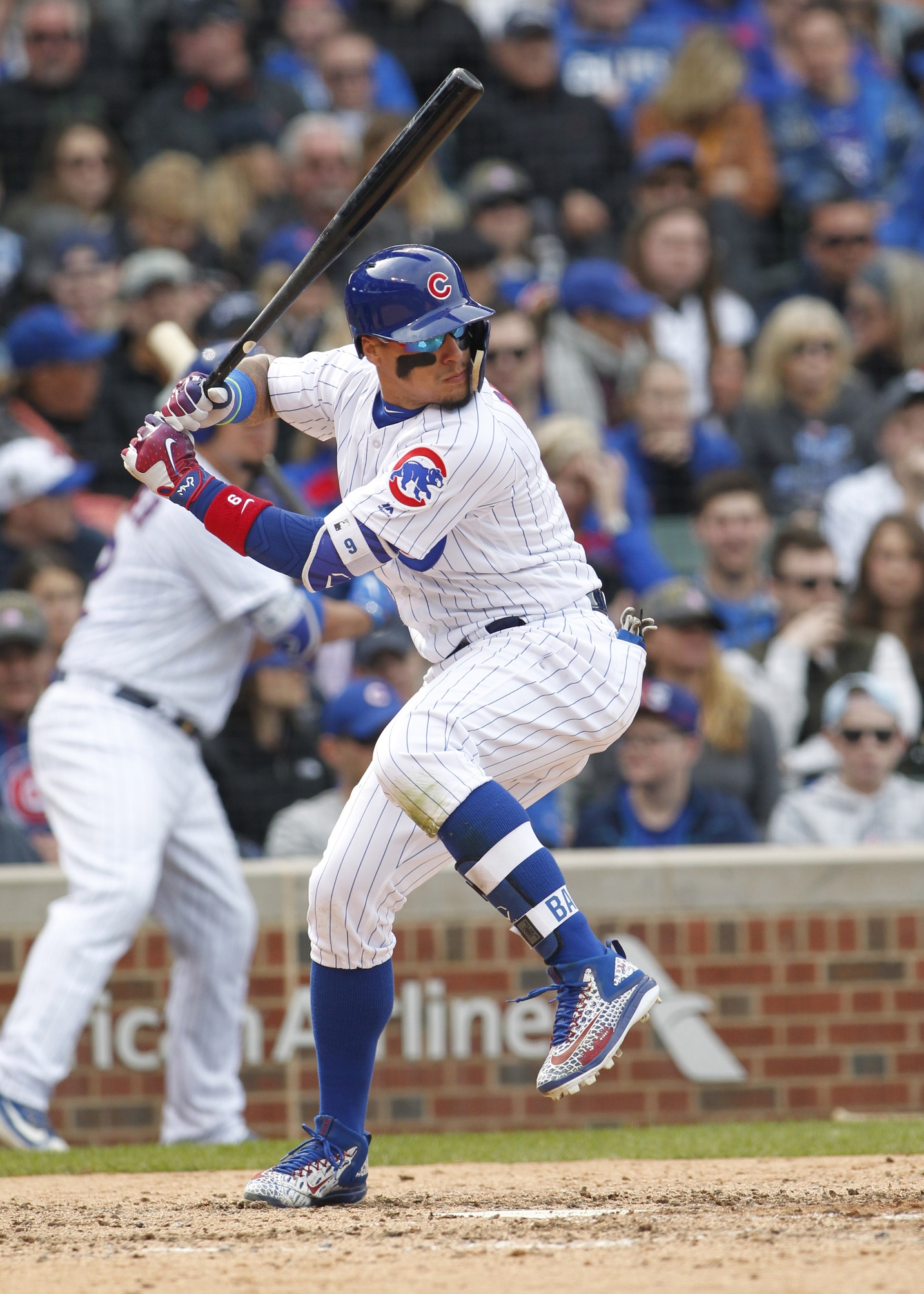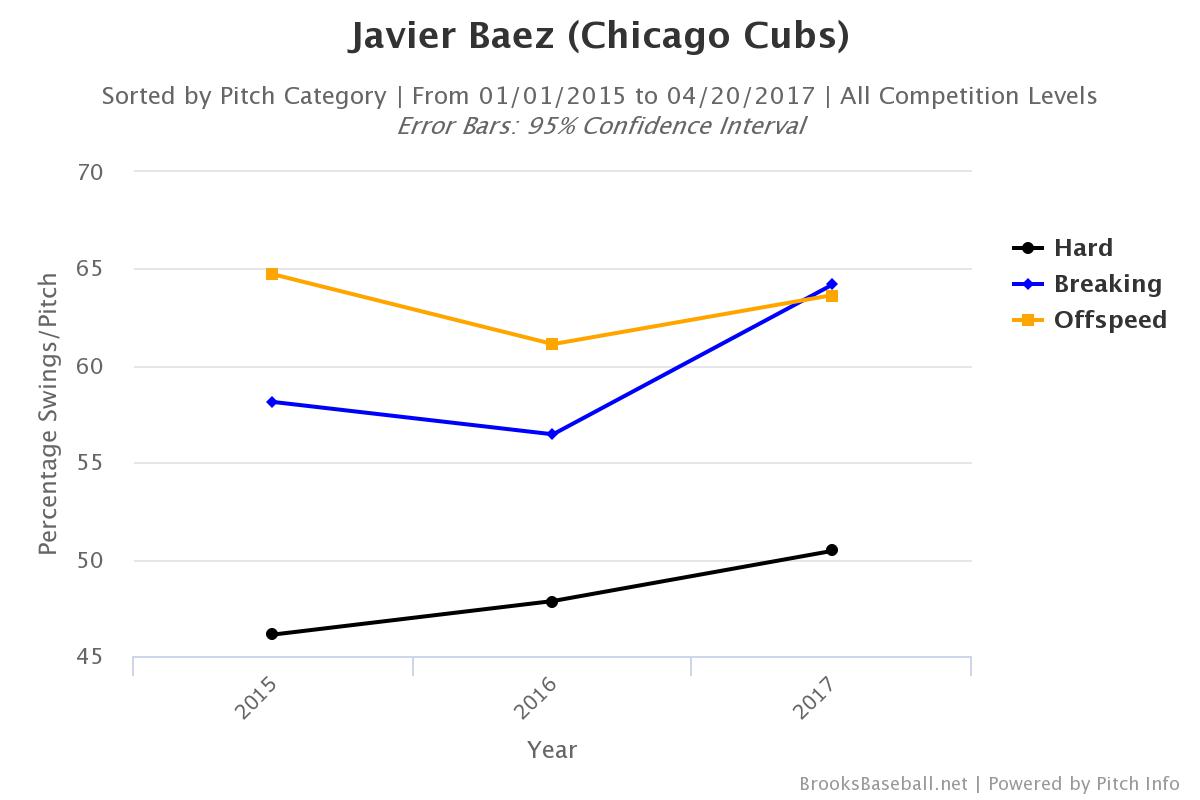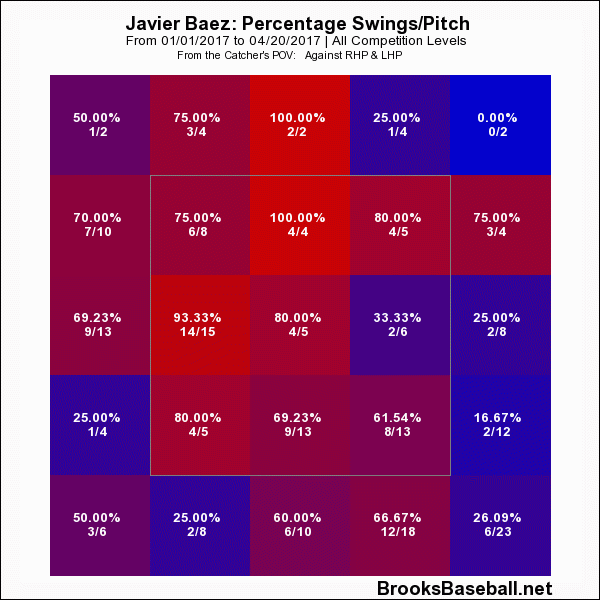Let me preface all of this by acknowledging that we’re barely two weeks into the 2017 season, and with sample size in mind, it’s extremely difficult to make too much of an assertion about a lot of things at this point. This isn’t meant to be a hot take or a panicky one in any sense. But as we begin to close in on the end of April, there are some concerns about the approach of Javier Báez that should probably be addressed.
The 2017 season was supposed to be the Year of Javy. In fact, that’s something I probably declared no less than 2,000 times before the season actually began. And it still very well could be that. His defense continues to astound us seemingly on a daily basis, both with the glove and the arm. But it’s really difficult to showcase a season as your breakout campaign when you’re experiencing the types of tribulations that Báez is already going through so early in the season.
Almost to the point where he looks like it’s 2014 all over again.
Of course, he’s not striking out over 40 percent of the time like he did in his first big league action. But the same types of concerns over the approach are there. Pitchers are getting him to bite on pitches well outside of the strike zone on a regular basis, and the early figures don’t paint the prettiest of pictures for Chicago’s darling infielder.
| PA | AVG | OBP | K% | BB% | ISO | TA v |
|---|---|---|---|---|---|---|
| 43 | .205 | .262 | 30.2 | 7.0 | .077 | .211 |
That’s, uh, not ideal. It’s not that anyone expects Báez to be an on-base machine. Even if his approach continued to evolve, virtually no one expected it to do so to the point where he’d be a true on-base threat with legitimate regularity. With that idea in mind, it’s probably unreasonable to expect a terribly high isolated power figure as well, because of the consistency issues he’ll continue to battle throughout his career. Nonetheless, those early average and OBP numbers are absolutely brutal, even within a small sample size. It’s not as if he’s running into a lot of bad luck, either. His batting average on balls in play currently sits at .320.
We know that based off of his skill set alone that Baez is better than what his production indicates. As such, we don’t need to look too far to know that much of his current struggles are related to his approach. His swing rate is illustrated below:
Swing rates are up across the board. FanGraphs has his overall Swing% up three percent from last year, at 55.6 percent. Interestingly enough, those same figures have his swing rate on pitches inside of the strike zone coming down a couple points, at a 64.3 percent clip, while his Swing% on those pitches out of the strike zone has shot up about eight percent, to an unnerving 50.0. His swinging strike rate, at 21.4 percent, is the highest of his career, and represents about a seven percent increase from each of the last two years, where his approach looked like it was improving. His whiff rate has jumped up primarily against hard stuff and offspeed pitches, as indicated over at Brooks.
Just to add another layer to this, here is where Baez is swinging, in terms of the overall zone:
The fact that there’s not even a semblance of a concentrated area in which Baez is focusing on really speaks to his complete lack of an approach at this point. Opposing pitchers are becoming acutely aware of this, and a quick look at virtually any of his at-bats this season would almost certainly indicate such.
There’s a less-quantifiable body language factor to all of this as well. It’s definitely apparent that Javy is frustrated and not completely dialed into his plate appearances this season, giving in way too easily to pitches outside of the strike zone. It’s as if opposing pitchers, regardless of the arm, can just toss a pitch anywhere and bait Baez into hacking.
But the overwhelming obviousness of Báez’s lack of approach this season doesn’t make it any less of a concern. From the Cubs’ perspective, though, how do they get Javy out of his own head and get him on a path toward fixing these early woes at the plate?
For one, some rest might be a good place to start. Allow him to hit the reset button and start over with a day or two off or serving exclusively as a defensive replacement, keeping him away from the batter’s box. Really that could be the beginning and end of it. Because we know that Javy Báez is capable of making the adjustments. He’s done it before.
He continued to make those adjustments from 2014-15 into 2016 and they were easily perceptible. His contact rate increased over the course of three years, gradually going from about 56 percent in 2014 to about 70 percent last season, while that SwStr% came down over the same span of time. Again, we know that Baez is as committed as anyone to making those adjustments. At this point, one hopes it’s more of a mental hurdle that he needs to overcome than any permanent mechanical issue. If he can get the mindset sorted out and get back to a point where he’s maintaining that “slightly selective, predominantly aggressive” approach and swinging at a better quality of pitches, we’ll see Báez get back on track to where he needs to be before long.
Lead photo courtesy Caylor Arnold—USA Today Sports



It is worse than it looks. I believe all 3 of his walks have been intentional, so effectively his walk rate is 0% and his OBP is around 250.
Correction, I made a simple mistake. Excluding the 3 intentional walks, Jack’s OBP would be 205, or slightly higher if he has a HBP.